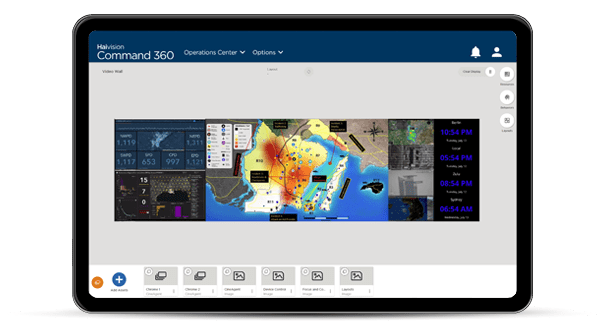Organizations rely on video wall systems as a visual collaboration tool that can aid in making mission-critical decisions fast. Changes in use case, technology, environment, or size can drive the need for flexible system components. To properly meet the entire lifecycle of an operations center, video walls must be designed to meet current and future scalability.
Simply put, scalability is the ability to handle growth and additional resources over time. For visualization systems used in ops centers, scalability is often determined by the number of inputs and outputs. However, adding capacity isn’t the only way to scale.
It’s important to consider technology that coincides with present and future workflows. Most times, organizations don’t fully understand their functional requirements until a solution is implemented and in use. Choosing the right visual collaboration technology provider to help your organization adapt to existing and evolving requirements is critical. Let’s explore considerations for the implementation of new functionality to meet changing needs.
Multiple Video Walls
Operations centers sometimes need multiple video walls within the same facility. This provides the ability to share content between departments or teams, often in different rooms, a vital capability for mission-critical environments.
Source Control
The ability to segment “real estate” of a display wall for specific users with their own layout control has distinct benefits. Having control permissions in place reduces the risk of inadvertently displaying the wrong information with common actions such as recalling a preset layout. These issues can be addressed with video wall management software that allows organizations to control what content various sources can display.
Independent Displays
It is quite common for leadership to access situational data from the operations center floor. Independent displays can access sources and deliver limited functionality in offices or conference rooms. For example, the operations center conference room may need a subset of the content on the main video wall for incident management.
Local Applications
It may be a waste of resources to dedicate a workstation to display web pages or run static applications like PowerPoint. The ability to automate these tasks and manage them as visual assets reduces error and user workload.
Source Capture
Another indirect feature, often requested after video wall installation, is the ability to capture real-time feeds for future playback. This may be for archive purposes, training, or to brief leadership without needing staff on hand to do so. Network sources feeding the display wall can capture and play back with standard off-the shelf hardware.
A display wall is a support component that must meet the needs of an organization today as well as known and unknown requirements down the road. Considering and allowing for these future requirements while choosing the right video wall technology maximizes the investment and provides opportunity for unlimited scalability.
Haivision MCS’s CineNetTM Platform offers unparalleled flexibility to configure a video wall solution to meet any organizational workflow. Learn more about detailed scalability considerations to meet both your current and future needs in our white paper, Evaluating Scalability for Control Rooms. Request your free copy of this white paper.
